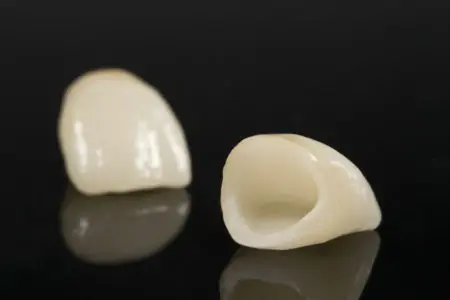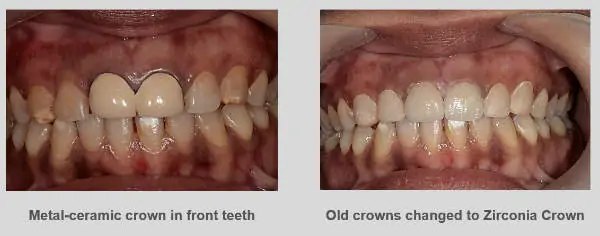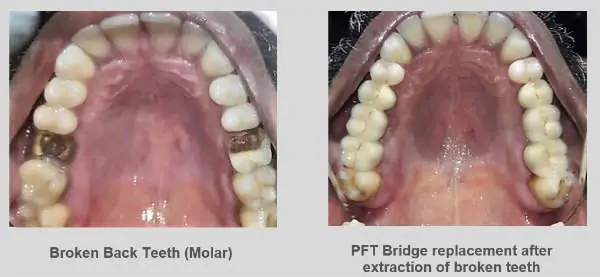Zirconia Crown & Bridge
Change The Way You Smile…. With CAD/CAM Zirconia Crown & Bridge

Crowns for teeth reinforce the structure of the tooth, improve the tooth’s function and are used to cap or cover teeth after a root canal treatment. Crowns for teeth are usually made from different materials. While most crowns today are Ceramic crowns, the ceramic can be layered over Zirconia (All-ceramic) or fused with metal or gold (metal-ceramic).
In all cases, they provide great results – making your teeth and smile more appealing. Zirconia crown is the most preferred material for crowns on teeth.
At Dr Smilez Dental Center, we provide superior quality CAD/CAM Zirconia crown. Zirconia crown is metal-free and is much more durable, have high strength and aesthetics compared to the conventional metal-ceramic Crowns, making the preferred choice among dental crowns. Some premium Zirconia crown comes with a 15- 20 years warranty.
Benefits of Zirconia Crown
- High strength – Zirconia crown is the strongest dental crowns. Even the layered zirconia crown is much stronger than the metal-ceramic crown making them the material of choice for crowns on back teeth.
- Translucent with Superior aesthetics & Perfect shade match with adjacent tooth – Different types of Zirconia crown is available based on the tooth that requires the crown. High translucent zirconia is the preferred type of Zirconia crown for front teeth as it looks the most natural
- No metal margin exposure & Gentle to the gums – Crowns usually are fitted at or slightly below the gum margin. With ageing and some gum recession, the margin of the metal ceramic crown is usually seen as a dark grey line. With a Zirconia crown, the margin is also white maintaining the aesthetics even with gum recession.
- Completely Biocompatible – There is no known allergy reported to a Zirconia crown whereas some metals used in metal-ceramic crowns are known to cause allergies especially in patients with a history of metal allergies.

F.A.Q on Zirconia Crown
Solid Zirconia crown is of higher strength and more opaque and is ideally suited for back teeth as they can withstand heavy chewing forces easily.
Translucent Zirconia crown is more aesthetic and of less strength compared to solid Zirconia. They are best suited for front teeth where the importance is on naturalization and forces of chewing is minimal.
Based on the above types, there are many brands of Zirconia crown available such as Bruxzir Solid Zirconia, 3M Lava, Prettau Zirconia, Cercon etc.
The choice of crown mainly depends on the tooth i.e., front tooth or back tooth, number of teeth to be replaced in case of bridge, the warranty period and definitely the preferred spend by the patient. As you dentist, we will suggest the best type of crown for you based on the above parameters. It is recommended that your dentist makes the choice and give you some options based on spend preference.
The cost of a single Zirconia crown ranges between INR 10000 up to INR 25000. All Zirconia crowns come with a warranty ranging from 10 years to lifetime depending on the type.
Any crown fitting required two appointments with an interval of 3-5 days depending on the number of teeth. In the first visit, the tooth is shaped and measurement is made for the CAD designing. The measurement is scanned using CAD and the crown is custom made for each tooth separately. In the second visit, the dentist will fit the crown permanently on the tooth. Sometimes for front teeth or in case of multiple teeth replacement, a fit check and/or shade check appointment will be required in order to get perfect results.
Most Zirconia crowns will last for 15-20 years without any problems. The longevity of the crown is primarily dependent on the oral hygiene maintenance and meticulousness with which the dental care instructions are followed by the patient.
2. Sometimes they can cause wear and tear in the opposing tooth due to their high strength
NO.With proper oral hygiene maintenance, Zirconia crown does not change colour.
YES. Zirconia crown comes with a minimum 10-year warranty. Some of the premium crowns have lifetime warranty. What it means is that if there are any chips or breaks in the crown, the crown is replaced without any cost to the patient. Warranty does not include breakage of tooth per se due to accidents or decay from poor oral hygiene and if the tooth is lost due to gum disease or accidents.
Sometimes, a limited budget may make Zirconia crown seem more expensive. While in current dental practice, Zirconia crown is definitely the better choice, there are other less expensive crown options available such as metal-ceramic crowns.
Metal-Ceramic Crowns (Porcelain fused to Metal Crowns)
Before the introduction of Zirconia crown, metal-ceramic crowns were the mainstay for crowns on teeth. They are still in use and sometimes maybe even preferred to a Zirconia crown in certain clinical situations.
Metal ceramic crowns have a core made of an alloy of mainly Ni-Cr or Co-Cr. The metal used can also be Gold, but Gold-ceramic or pure Gold crowns are very expensive. One of the main problems with the metal alloy was the lack of quality control on the alloy properties and also, they were handmade and not computer-designed.
Metal ceramic crowns have also seen improvements in the fabrication process. Today, we are able to provide a better fit of crowns with DMLS crowns (Laser sintered crowns) and have better control over the quality of metal alloy used. However, all metal ceramic crowns have a few limitations.
Disadvantages of Metal-ceramic crowns
- Opaque; hence reduced aesthetics for front teeth
- Metal margin exposure with time
- Bulky and heavy due to metal weight
- Possibility of chipping of the ceramic
- Perfect shade match difficult due to opacity
- Metal corrosion over a period of time

NEWER CROWNS
One of the main disadvantages of conventional alloy for metal-ceramic crowns and bridges is the weight of the crowns and the compromised aesthetics due to metal thickness. In order to make crowns lighter and thinner, newer alloy systems use Titanium as the core metal.
Titanium crowns are new entrants in dental practice. Titanium is the most biocompatible material and can be used in its pure form (PFT – Porcelain fused to Titanium) or as a pure ceramic alloy with Titanium (TILITE). This makes the crown light and slightly flexible while maintaining strength. PFT is an ideal material of choice for bridges especially for back teeth when dental implants are not the replacement choice.

Dental Bridges
Dental Bridges at Dr Smilez Dental Center in Chennai
Dental Bridges replace one or more missing teeth. A dental bridge takes the support of teeth or implants with the missing teeth joined with the supporting crowns. A bridge replaces a missing tooth by means of two, or more, crowns which are ‘bridged’ by an additional tooth on the area of the missing tooth. Bridges are basically multiple crowns joined together and is made in the same materials used to make crowns such as Zirconia crown or Metal-ceramic crown. A bridge is a less preferred option to replace missing teeth when adequate bone is available to place a dental implant. In some clinical situations, the dentist may recommend a bridge over a dental implant when the success of the implant is questionable or if additional procedures such as sinus lift of bone augmentation is required before placing an implant.

Key Benefits of Dental Bridge
- Missing tooth is replaced
- Support and protection for the compromised teeth
- Immediate results
- Natural/improved appearance
- Restoration to normal or improved functioning
Treatment Procedure for Crown & Bridge
The procedure requires two visits, but usually depends on the number of crowns needed. During the first appointment the teeth are prepared by circumferential reduction to make room for the supporting crowns. An impression (or mould) is then taken for fabrication to a laboratory and a plastic temporary crown/ bridge is fitted for the interim period. The fabrication at the laboratory takes approximately 3-4 days. During the next visit, the temporary crown/bridge is removed and the Zirconia crown/bridge is permanently cemented into place.
